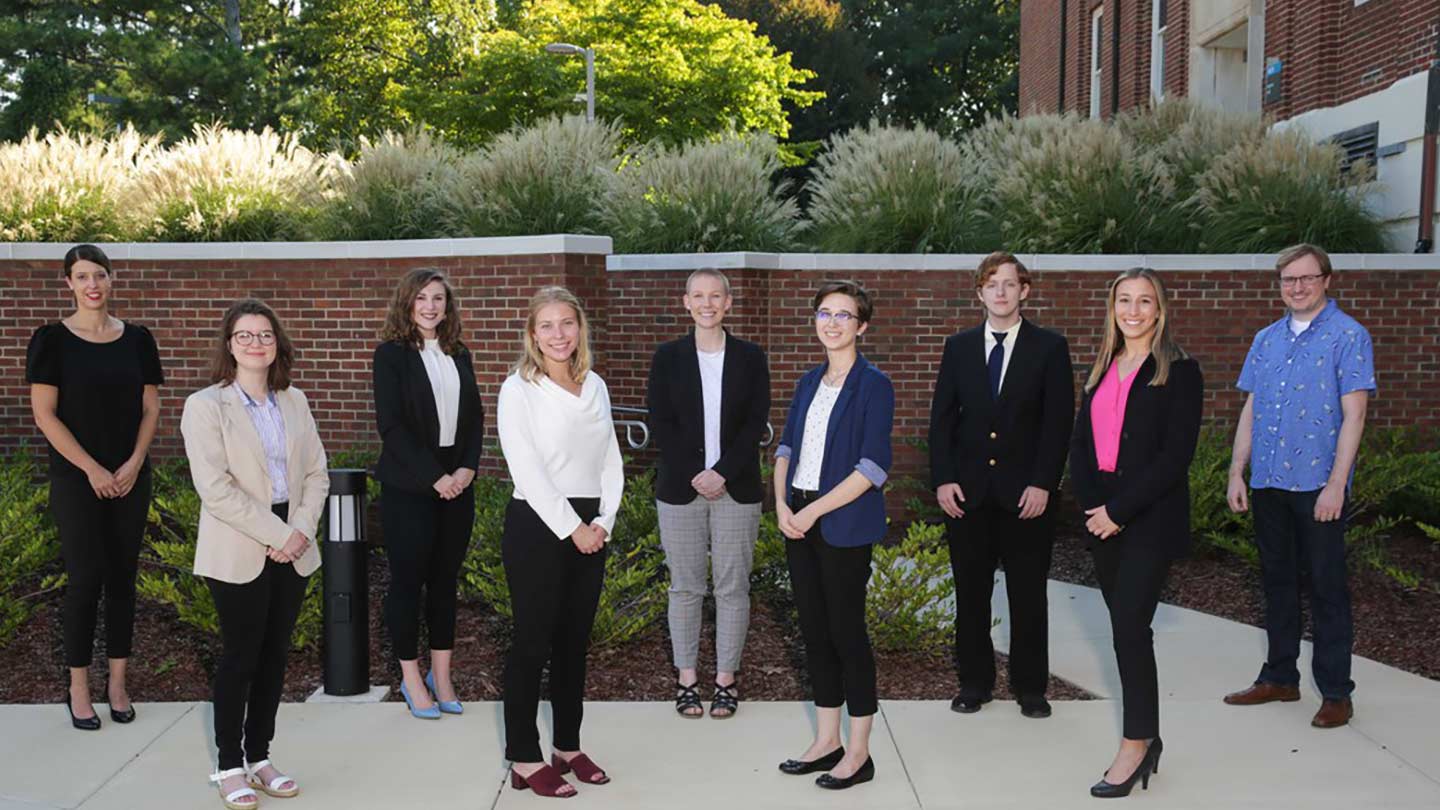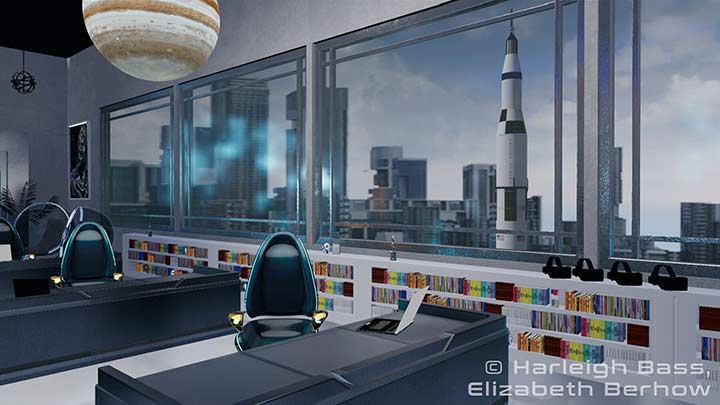
(L-R) Dr. Kristin Weger, co-PI and Assistant Professor, Psychology Department; Elizabeth Berhow; Art and Animation student; Anna Shipman, INCLUDE Project Manager and Industrial and Systems Engineering student; Alana Flint, Industrial and Systems Engineering student; Rosemary Cortelli, Industrial and Systems Engineering student, Psychology student; Harleigh Bass, Art and Animation student; Andrew Atchley, Philosophy student; Hailey Simon, Industrial and Systems Engineering student; Dr. Bryan Mesmer, PI and Associate Professor, ISEEM Department.
Michael Mercier | UAH
While billionaires like Amazon’s Jeff Bezos and Virgin Galactic’s Sir Richard Branson are offering to make touching outer space a reality – at a price! – faculty and undergraduates at The University of Alabama in Huntsville (UAH), a part of The University of Alabama System, are taking a radically different approach to achieving this dream.
Faculty members from the UAH Colleges of Engineering and Arts, Humanities & Social Sciences have devised a program called INCLUDE, an Interdisciplinary Undergraduate Experience tasked with the goal of “conceptualizing a space ecosystem” as a jumping-off place for a journey to the stars for everyday explorers.
The program is the brainchild of Dr. Bryan Mesmer, an Associate Professor in UAH’s department of Industrial & Systems Engineering and Engineering Management (ISEEM), working in collaboration with Dr. Kristin Weger, an Assistant Professor of Psychology in the College of Arts, Humanities and Social Sciences (CAHS). INCLUDE was piloted successfully over the previous fall and spring semesters as a project dedicated to examining the daunting hurdles and opportunities most likely to affect the future of humankind.
“Dr. Mesmer was the creator of INCLUDE, and together we collaborated to get this program set up and rolling,” Dr. Weger explains. “It’s the first of its kind at UAH and entails interdisciplinary work by a student team to tackle a Grand Challenge.”
A ‘Grand Challenge’ is defined as a significant problem or obstacle facing society that requires solutions beyond the reach of ordinary research. The end results or outcomes of these efforts are seen as potentially globally beneficial in scale, and ultimately achievable through a collaboration of many technical and non-technical disciplines.
“INCLUDE came about through the needs for interdisciplinary work to address 21st century research questions and in response to our students being thrown into the workforce where they will be interacting immediately with diverse people from disciplines that are not the student's own,” Dr. Mesmer says. “Many of the students – up until INCLUDE – have only interacted significantly within their own disciplines, and that is just not how the real world works.”
Grand Challenges require coordinated, collaborative and collective efforts to succeed. A Challenge can run the gamut from engineering, government and military problems, to projects involving mathematics, medicine and health, science and technology, or any number of other technical and non-technical fields important to human civilization. Dr. Mesmer describes just how this works within the scope of the new program.
“With the guidance of a steering committee of mentors from both academia and practice, students immerse themselves in a project that explores innovative approaches and models to a predefined Grand Challenge. The Challenge presented to student teams requires knowledge and experiences from multiple disciplines, with best solutions found at the intersection of each discipline. The project also examines the distinctive characteristics and missions of the independent disciplines that enable solutions to the world’s largest challenges. The project for the 20-21 academic year is in collaboration with NASA, Dynetics and AOA. For the University, it is a way to get faculty from diverse colleges and departments working together. For industry, it is a way to give back to the community and also identify potential employees in the students.”
The steering committee advises the team on each project from start to completion and includes practitioner mentors from key organizations that have a particular expertise to lend to the project and academic mentors of UAH from diverse colleges and departments. For the pilot project, practitioner mentors were brought in from three organizations representing government (NASA), the aerospace industry (Dynetics) and themed entertainment systems (AOA).
“Those individuals were Mike Watson and Robert Moreland (NASA); Darrin Burnett, Tony Lindeman and Dr. Diane Aloisio (Dynetics); and Tom Acomb and Mike Ostendorf (AOA),” Dr. Mesmer notes. “The faculty had prior relationships with these organizations and individuals, and they were excited to participate in mentoring an interdisciplinary group.”
The Grand Challenge offered to the group as the pilot project involved exploring cutting-edge solutions and designs to solve important space-related problems and answer these two questions: 1) Can a multi-country, mixed commercial, government, civilian and military Space Ecosystem be viable in 2030, 2040 and 2050? And 2) How to best creatively assess expectations and engage society in the future Space Ecosystem?
“The faculty team identified the Grand Challenge, which was chosen to be relevant to near-future concerns (such as space ports) that students may encounter in their careers,” Dr. Mesmer says. “The pilot year demonstrated that the INCLUDE program has significant benefits to the University, to industry and, most importantly, to the students. The students got hands-on experience working in a diverse team on a project that is future-looking and informed by a diverse industry team.”
To mentor the team, academics from colleges and departments across the UAH campus were selected to provide perspectives from their various disciplines, including Dr. Bryan Mesmer (ISEEM); Dr. Kristin Weger and graduate student Sheri Leder (Psychology); Amy Guerin (Theatre), Vinny Argentina (Animation and Game Design); Dr. Nicholaos Jones (Philosophy), Dr. Liwu Hsu (Marketing) and Dr. Nicholas Loyd (ISEEM).
“The student teams consist of junior or senior undergraduate students selected from diverse colleges and departments,” Dr. Mesmer says. “Student participants will experience cultural and social challenges and benefits to working in a highly diverse team. Mentors provide guidance and knowledge to the teams, encouraging novel, yet rigorous, solutions. Through its students, mentors and university support, INCLUDE will provide a capstone experience to prepare students for the diverse organizations and interdisciplinary challenges they will face in the workforce.”
Undergraduate contributing team members were identified by the faculty advisors in courses and through calls for students. The spokesperson and project manager from the student side has been Anna Shipman in the department of Industrial & Systems Engineering and Engineering Management.
“The group consists of SE, Psychology, Art and Philosophy students,” Shipman says. “This last semester they brought on a Marketing student as well. My role as Project Manager is to ensure there’s a smooth flow between all the disciplines and ensure the students are routinely communicating with each other. I interface with the stakeholders, students and advisors.” Other student team members include Hailey Simon (ISEEM), Rosie Cortelli (ISEEM/Psychology), Alana Flint (ISEEM), Hailey Heaton (Psychology), Harleigh Bass (Art/Animation), Elizabeth Berhow (Art/Animation), Madison Travis (Digital Marketing & Entrepreneurship) and Joseph Atchley (Philosophy).
Shipman is excited about the program and its possibilities. “It’s an honor to be on the project! We took those Grand Challenge questions and looked at several ‘new space’ companies, such as Blue Origin, Virgin Galactic and Space X, and saw what they doing in the commercial space sector, as well as a few companies that focus more on sustainability and repurposing space debris, things like that. We saw the gaps that existed in industry and from there developed a proposal we thought would address those gaps.”

Courtesy Harleigh Bass, Elizabeth Berhow
The psychology students on the team administered a survey to 250 members of the community and UAH to solicit preferences about the proposed space port to answer questions about things such as preferred amenities and the cost they would be willing to pay to go to space.
“We’re focusing on an Earth-based space port that offers amenities to a range of economic backgrounds and is more accessible than the current space tourism offerings,” Shipman says. “So this space port is a blend of Space Camp with Disney World, and it sounds very futuristic and ‘sci-fi,’ but it could very much be a reality, which is the cool part of it! We want our space port to be kind of a resort-style offering. So, people could come to the resort and look at museum exhibits or go through Space Camp-style training experience or even go to space, if they can afford it.”
The science and engineering students have been focused on modelling the space port, as well as developing requirements and determining economic frameworks for the project, resulting in a first-place finish at Research Horizons Day for the College of Engineering for co-authors Shipman and Rosemary Cortelli, Alana Flint, Hailey Simon, Harleigh Bass, Elizabeth Berhow, Andrew Atchley and Madison Travis.
“The AA student will be finalizing the VR program,” Shipman notes. “The marketing student will be helping us tie all these pieces together and come up with a pitch and website and something to sell to society. The PH student and a SE student are working on space policy, which is really cool, because there’s a huge lack of space policy in the aerospace industry. They’ll be addressing the challenges of developing a space port that could potentially have commercial tourists, government facilities and also launch government satellite payloads.”
The team’s interdisciplinary strengths helped them grapple with far-ranging topics, such as the psychological rigors of space travel, the legal and political obstacles such an “ecosystem” might encounter, and finding ways to make space travel more accessible and equitable. With the current cost of “commercial” space travel ranging from $250K for a sub-orbital flight to $20M+ to actually achieve orbit, the team instead emphasized engaging the widest spectrum of society possible, regardless of a traveler’s educational background or financial standing. The goal was to offer everything from mission-style physical or virtual reality simulations to real astronaut training, museum exhibits, resort-style “immersive” entertainment and, ultimately, the opportunity to actually lift off.
Rosemary Cortelli, a dual-degree student majoring in both Industrial & Systems Engineering and Psychology, says INCLUDE has provided her the perfect chance to involve both her passions in one project. “I wanted to participate in the program because it seemed like an excellent opportunity to combine my psychology and engineering capstones, work on a space-related project with other enthusiastic people, and gain mentors in the space industry.
“On the engineering side, I am exploring space systems, mission design and spaceport concept requirements,” she adds. “On the psychology side, I am investigating the community's preferences for general space travel, healthcare, training and team composition. I would definitely recommend the INCLUDE program to other students, because it is a great way to learn about and become involved with multiple disciplines in solving a larger, complex issue.”
Dr. Mesmer agrees as he looks to the future of the program. “We see this as a yearly effort tackling new Grand Challenges,” he says. “The 2021-2022 Grand Challenge involves robotic systems interacting with each other in a ‘sport’ competition.”